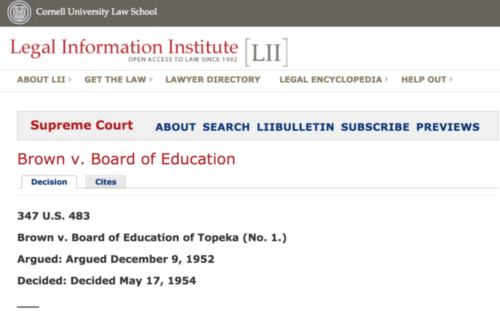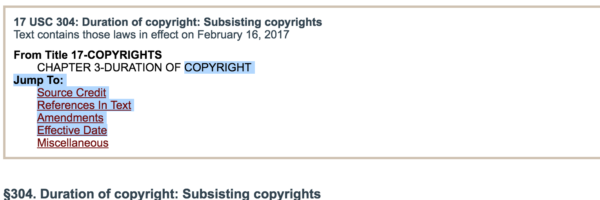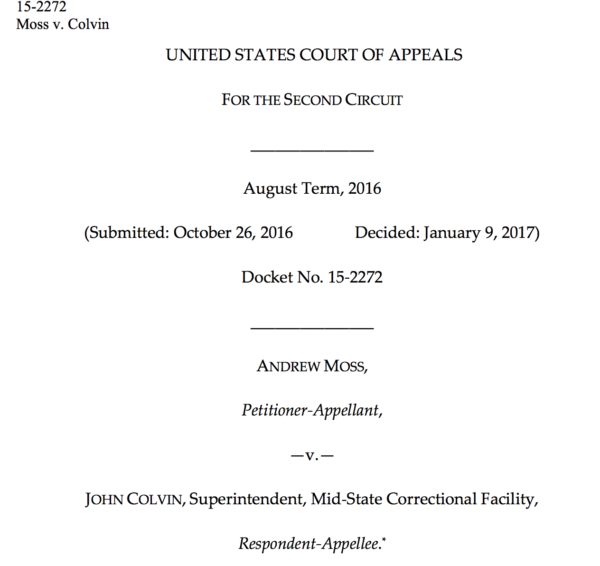How to Cite the Bill of Rights Mla
Gaining familiarity with the legal-citation practices used to document legal works may be impractical for student writers and sometimes even for scholars working in nonlegal fields. Nonspecialists can use MLA style to cite legal sources in one of two ways: strict adherence to the MLA format template or a hybrid method incorporating the standard legal citation into the works-cited-list entry. In either case, titles of legal works should be standardized in your prose and list of works cited according to the guidelines below.
Legal Style
Legal publications have traditionally followed the style set forth in the Harvard Law Review Association's Bluebook: A Uniform System of Citation, although some law reviews, such as the University of Chicago Law Review, have published their own style manuals. A more streamlined version of the Bluebook's legal-citation method, the ALWD Guide to Legal Citation, was introduced in 2000. The Legal Information Institute, a nonprofit associated with Cornell Law School, publishes an online guide to legal citation geared toward practitioners and nonspecialists instead of academics.
Those working in law are introduced to the conventions of legal citation during their professional training. Legal style is a highly complex shorthand code with specialized terminology that helps legal scholars and lawyers cite legal sources succinctly. It points specialists to the authoritative publication containing the legal opinion or law, regardless of the version the writer consulted.
MLA Style
Students and scholars working outside the legal profession and using MLA style should follow the MLA format template to cite laws, public documents, court cases, and other related material. Familiarize yourself with the guidelines in the MLA Handbook, section 2.1.3, for corporate authors and government authors.
Following one of the fundamental principles of MLA style, writers citing legal works should document the version of the work they consult—not the canonical version of the law, as in legal style. As with any source in MLA style, how you document it will generally depend on the information provided by the version of the source you consulted.
Titles pose the greatest challenge to citing legal works in MLA style. Since MLA style keys references in the text to a list of works cited (unlike court filings, which cite works in the text of the brief, or academic legal writings, which cite works in footnotes ), writers should, with a few exceptions (noted below), standardize titles of legal sources in their prose and list of works cited. Following the MLA Handbook, italicize the names of court cases (70):
When you cite laws, acts, and political documents, capitalize their names like titles and set them in roman font (69):
When a legal source is contained within another work—for example, when the United States Code appears on a website that has a separate title—follow the MLA Handbook and treat the source as an independent publication (27). That is, style the title just as you would in prose—in italics if it is the name of a court case, in roman if it is a law or similar document; even though the legal source appears within a larger work, do not insert quotation marks around the title:
For more on titles in legal citations in MLA style, see "Tips on Titles," below.
Commonly Cited Sources
A few examples of using MLA style for commonly cited legal sources follow.
- United States Supreme Court Decisions
- United States Supreme Court Dissenting Opinions
- Federal Statutes (United States Code)
- Public Laws
- Federal Appeals Court Decisions
- Federal Bills
- Hearings
- Executive Orders
- State Court of Appeals, Unpublished Decisions
- State Senate Bills
- Constitutions
- Treaties
- International Governing Bodies
United States Supreme Court Decisions
Where you read the opinion of a United States Supreme Court decision will dictate how you cite it in MLA style. Legal-citation style, in contrast, points to the opinion published in the United States Reports, the authoritative legal source for the United States Supreme Court's decisions, and cites the elements of that publication.
For example, the case Brown v. Board of Education is commonly abbreviated "347 U.S. 483" in legal citations: 347 is the volume number of United States Reports; "U.S." indicates that the opinion is found in United States Reports, which is the official reporter of the Supreme Court and indicates the opinion's provenance; and the first page number of the decision is 483. (The American Bar Association has published a useful and concise overview of the components of a Supreme Court opinion.)
Regardless of the version you consult, you must understand a few basic things about the source: that it was written by a member of the United States Supreme Court on behalf of the majority and that, when you cite the opinion, the date on which the case was decided is the only date necessary to provide.
Following are examples of works-cited-list entries in MLA style for Brown v. Board of Education. The entries differ depending on whether the information was found on the Legal Information Institute website, published by Cornell University Law School, or on the Library of Congress website.
Legal Information Institute

The works-cited-list entry includes
- the government entity as author
- the name of the case ("Title of source" element)
- the year of the decision; it would also not be incorrect to include the day and month if it appears in your source
- the title of the website containing the case ("Title of container" element)
- the publisher of the website
- the website's URL ("Location" element)
Library of Congress

The Library of Congress site allows researchers to link to or download a PDF of the opinion from the United States Reports. To locate the case, the researcher must know the volume number of the United States Reports in which Brown v. Board of Education was published. A works-cited-list entry in MLA style would include the author (the government entity) and the title of the case, as well as the following information for container 1:
- United States Reports ("Title of container" element)
- vol. 347 ("Number" element)
- the date of the decision ("Publication date" element)
- page range ("Location" element)
Container 2 includes the name of the website publishing the case and its location, the URL. The publisher of the site is omitted since its name is the same as that of the site.
United States Supreme Court Dissenting Opinions
Sometimes, Supreme Court justices write dissenting opinions that accompany the published majority opinion. They are part of the legal record but not part of the holding—that is, the court's ruling. If you cite only the dissent, you can treat it as the work you are citing:
Federal Statutes (United States Code)
In MLA style, it will generally be clearest to create an entry for the United States Code in its entirety and cite the title and section number in the text, especially if you are referring to more than one section of the code.
If an online search directs you to the web page for a specific section of the United States Code, it would not be incorrect to cite the page for that section alone. For example, if you want to use MLA style to document title 17, section 304, of the United States Code—commonly abbreviated 17 U.S.C. § 304 in legal citations—title 17 can be treated as the work and thus placed in the "Title of source" slot on the MLA template, or if you cite the United States Code in its entirety, title 17 can be placed in the "Number" slot.
Your entry will once again depend on the version you consult. Below are examples from various websites.
website for the United States Code

On the website for the United States Code, you would likely determine that the United States House of Representatives is the author of the code. The United States Code is the title of the source, and since the source constitutes the entire website, no container needs to be specified: the source is self-contained, like a book (see p. 34 of the MLA Handbook). The site lists the Office of the Law Revision Counsel as publisher, so you would include that name in the "Publisher" slot, followed by the date on which the code was last updated, and the URL as the location:
The body of your text or your in-text reference must mention title 17 and section 304 so the reader can locate the information you cite. It would not be wrong to include chapter 3 as well (title 17, ch. 3, sec. 304), although a discerning researcher will note that section numbers (304) incorporate chapter numbers (3), making "chapter 3" unnecessary to include.


If you do not include title 17 and section 304 in the text, you must include that information in the works-cited-list entry:
Legal Information Institute
A nonspecialist would not be able to determine from the Legal Information Institute site that the United States House of Representatives is the author of the United States Code. A basic citation would include the title of the code as displayed on the site, the title of the website as the title of the container, the publisher of the website, and the location:
Government Publishing Office website
The website of the Government Publishing Office (variously referred to as the Government Printing Office) displays each statute heading (or "title") as a web page:

You can treat title 17 as the work and the United States Code as the title of the container, as follows:
Or you can treat the United States Code as the title of the source and title 17 as a numbered section within the code, by placing title 17 in the "Number" slot on the MLA template:
Below are examples of how to cite other common legal sources in MLA style.
Public Laws
Federal Appeals Court Decisions

It is customary to title court cases by using the last name of the first party on each side of the v. You may also wish to shorten a long URL, as we have done here.
Federal Bills
Hearings
Executive Orders
After a president signs an executive order, the Office of the Federal Register gives it a number. It is then printed in the Federal Register and compiled in the Code of Federal Regulations. Executive orders usually also appear as press releases on the White House website upon signing.
State Court of Appeals, Unpublished Decisions
State Senate Bills
Constitutions
If a constitution is published in a named edition, treat it like the title of a book:
References to the United States Constitution in your prose should follow the usual styling of titles of laws:
But your in-text reference should key readers to the appropriate entry:
If the title does not indicate the country of origin, specify it in the entry:
Treaties
International Governing Bodies
Writing for Specialists: A Hybrid Method
A writer using MLA style to document a legal work for a specialized readership that is likely to be familiar with the conventions of legal documentation may wish to adopt a hybrid method: in place of the author and title elements on the MLA format template, identify the work by using the Bluebook citation. Then, follow the MLA format template to list publication information for the version of the source you consulted.
For example, to cite the United States Code using the hybrid method, treat the section cited as the work. As above, you can omit the title of the website, United States Code, since the code constitutes the entire website and is thus a self-contained work.
If you are citing a court case, begin the entry with the title of the case before listing the Bluebook citation. In the hybrid style, cite Brown v. Board of Education as found on the Legal Information Institute website thus:
Other sources (public laws, federal appeals court decisions, etc.) can be handled similarly.
If using the hybrid method, do not follow the handbook's recommendation to alphabetize works that start with a number as if the number is spelled out. Instead, list works beginning with numbers before the first lettered entry and order numbered works numerically.
TIPS ON TITLES
Styling titles when you document legal sources in MLA style may be challenging. Below are some guidelines.
- Standardize titles of legal sources in your prose unless you refer to the published version: as the MLA Handbook indicates, italicize the names of court cases, but capitalize the names of laws, acts, and political documents like titles and set them in roman font.
- When a legal source is contained within another work—for example, when the United States Code appears on a website with another title—follow the MLA Handbook, page 27, and treat the work as an independent publication. That is, style the title just as you would in prose—in italics if it is the name of a court case, in roman if it is a law or similar document; even though the legal source appears in a larger work, do not insert quotation marks around the title.
- In the names of court cases, use the abbreviation v. consistently, regardless of which abbreviation is used in the version of the work you are citing.
- To determine the name of a court case, use only the name of the first party that appears on either side of "v." or "vs." in your source; if the name is a personal name, use only the surname.
To shorten the name of a court case in your prose after introducing it in full or in parenthetical references, use the name of the first-listed nongovernmental party. Thus, the case NLRB v. Yeshiva University becomes Yeshiva. If your list of works cited includes more than one case beginning with the same governmental party, list entries under the governmental party but alphabetize them by the first nongovernmental party:
Refer to the nongovernmental party in your prose and parenthetical reference, alerting readers to this system of ordering in a note.
NOTE
Special thanks to Noah Kupferberg, of Brooklyn Law School, for assistance with these guidelines.
How to Cite the Bill of Rights Mla
Source: https://style.mla.org/documenting-legal-works/